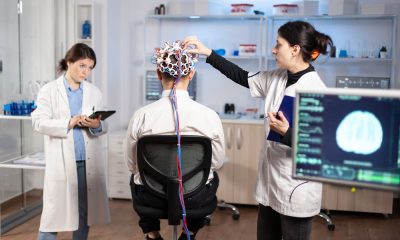News
Research sheds light on what it means to be middle-aged

A new study is shining a light on a part of life which is often overlooked – middle-age.
While a lot of research focuses on the very young or very old, middle-age – often seen as the longest phase of life – rarely gets much attention.
Dr Amy Barron’s work looks at what middle-age actually means to people living through it, and why it’s important to understand this period more fully.
She said: “Middle-age isn’t just a stepping stone between youth and older age – it’s where a lot of life happens.
“It’s full of change, emotion and meaning in its own right, but it is often ignored, reduced to stereotypes, or just assumed to be ‘normal’.
“It’s not just the middle of life – it deserves attention.”
Through interviews with people aged between 52 and 67 from Greater Manchester, the study explored how people define and experience being “in the middle” of life.
Rather than looking for strict age ranges or one-size-fits-all answers, participants were asked to reflect on their own experiences and how they see themselves.
Many shared that middle-age feels like a time of reflection, transition and sometimes uncertainty.
It’s a phase where people are no longer young, but don’t yet feel old. Some spoke about feeling “stuck” in their careers, or about health issues which made them more aware of their age.
Others mentioned enjoying the freedom that comes with no longer having young children to care for, or having more financial stability.
One participant joked that calling herself “middle-aged” would only make sense if she planned to live to 120.
Another said middle-age was more about mindset than years, while a third described it as a time to plan for a “good” older age, even while resisting the label “old.”
The research encourages people – and especially other researchers – to pay more attention to what happens in the middle of life, and not just focus on ‘childhood’, ‘youth’ and ‘older age’.
Dr Barron suggests we need ways of thinking about ageing that don’t rely on fixed stages or categories, because life is always in motion, always changing and our lives often don’t follow a linear path.
She also notes that everyone experiences middle-age differently – life events, family, health, work and even global events like the COVID-19 pandemic all shape how people feel about this time in their lives.
News
Researchers use prehistoric skeletons to study ageing

An archaeologist from the University of York is leading a new study into how societies viewed ageing, wisdom and experience over thousands of years.
Dr Lindsey Büster’s research claims to be the first to focus on the lives and experiences of older adults in prehistoric and Roman Europe, examining skeletons and objects from collections including York Museums Trust.
The project, called Age-Old Stories, aims to challenge existing stereotypes and ageism by exploring how earlier societies viewed age, wisdom and experience.
“They have a very large collection of Roman human remains from across Yorkshire and that’s going to be a really important assemblage for us,” said Dr Büster.
The ultimate aim is for the research to provide strong examples of why making older adults more visible in policy-making and public life is so important,” said Dr Büster.
“Ageing is not a marginal experience, it is a central part of human history and we should have better strategies for valuing and celebrating it today.”
Archaeological discoveries already suggest that older adults were central figures in many past societies.
In Scarborough, the remains of Gristhorpe Man – Britain’s best-preserved Early Bronze Age skeleton – were analysed and suggested he was aged between 45 and 60 years, tall and muscular, and nourished by a rich diet.
“He is over 45 and he was buried in this log coffin, which would’ve been hugely time consuming, hugely labour intensive and he’s buried with a dagger,” said Dr Büster.
“These are all the trappings of a high-status individual.”
The project will work in partnership with York Museums Trust to create a new exhibition and public events, and will also collaborate with Age Friendly York.
News
Weight loss jabs should be first-line obesity treatment in most cases, new guidance states

Weight loss jabs Mounjaro and Wegovy are so effective they should be the first treatment for obesity “in almost all cases”, according to new medical guidance.
The European Association for the Study of Obesity praised the drugs’ effectiveness and wider health benefits in new guidance to doctors.
It described them as slimming aids that can also cut the risk of related conditions such as high blood pressure and type 2 diabetes.
Three in ten Britons – around 16m adults – are obese, but only 1.5m use the injections, most bought privately at about £200 a month.
Trials have shown adults using semaglutide, the active ingredient in Wegovy and Ozempic, lost about 14 per cent of their body weight over 72 weeks.
Those taking tirzepatide – marketed as Mounjaro and sometimes dubbed the “king kong” of weight loss jabs – lost about 20 per cent over the same period.
Dr Andreea Ciudin, co-first author of the guidance from the Autonomous University of Barcelona, said the drugs were “completely transforming care of obesity and its complications”.
She added: “Even though there are several options on the market, the reality is that semaglutide and tirzepatide are so effective that they should be the first choice in almost all cases.”
The guidelines were produced by an international team of experts, including contributors from the UK.
They analysed existing studies and created an algorithm to help doctors decide the best treatment based on a patient’s weight and associated conditions.
They concluded that tirzepatide and semaglutide should be considered the “medications of choice” when a substantial level of total body weight loss is required.
When a lesser degree of weight loss is the aim, other medicines such as liraglutide, naltrexone–bupropion and phentermine–topiramate may be appropriate.
The guidance comes after health secretary Wes Streeting pledged this week to make injections available to millions more patients on the NHS.
Speaking at the Labour Party conference in Liverpool, he said it was unfair that wealthier people had been able to benefit from the drugs’ “transformative” effects “on their health, their confidence and their quality of life” while those unable to pay privately had gone without.
He added: “Weight-loss jabs could help us finally defeat obesity.
“Our mission is to ensure that the best science, the best healthcare and the best innovations are available not just to some, but to all.”
Wellness
Brain shape changes could offer early warning signs of dementia, study suggests

Ageing alters the brain’s shape in measurable ways that could provide early warning signs of dementia, potentially years before symptoms appear, researchers say.
Analysis of more than 2,600 brain scans from adults aged 30 to 97 revealed significant alterations in brain geometry linked to declines in memory, reasoning and other cognitive functions.
The inferior and anterior parts of the brain expanded outward, while the superior and posterior regions contracted inward. These uneven shifts were most evident in older adults showing cognitive decline.
Researchers at the University of California, Irvine’s Centre for the Neurobiology of Learning and Memory found that people with more pronounced posterior compression performed worse in reasoning tests, suggesting these geometric markers directly relate to brain function.
“Most studies of brain ageing focus on how much tissue is lost in different regions,” said Niels Janssen, senior author and professor at Universidad de La Laguna in Spain and visiting faculty at the CNLM.
“What we found is that the overall shape of the brain shifts in systematic ways, and those shifts are closely tied to whether someone shows cognitive impairment.”
One important implication involves the entorhinal cortex – a small but vital memory hub in the medial temporal lobe.
The study suggests age-related reshaping may press this region against the hard base of the skull.
The entorhinal cortex is one of the first areas where tau, a toxic protein linked to Alzheimer’s disease, accumulates.
The findings raise the possibility that mechanical and gravitational forces may contribute to its vulnerability in Alzheimer’s – a potential disease mechanism not previously considered.
“This could help explain why the entorhinal cortex is ground zero of Alzheimer’s pathology,” said study co-author Michael Yassa, director of the CNLM and James L McGaugh endowed chair.
“If the ageing brain is gradually shifting in a way that squeezes this fragile region against a rigid boundary, it may create the perfect storm for damage to take root. U
“nderstanding that process gives us a whole new way to think about the mechanisms of Alzheimer’s disease and the possibility of early detection.”
The researchers say their geometric approach could eventually provide new markers for identifying dementia risk, potentially before symptoms emerge.
“This isn’t just about measuring brain shrinkage,” added Janssen.
“It’s about seeing how the brain’s architecture responds to ageing and how that architecture predicts who is more likely to struggle with memory and thinking.”
The patterns were replicated in two independent datasets, reinforcing the consistency of these shape changes as a hallmark of ageing.
“We’re just beginning to unlock how brain geometry shapes disease,” said Yassa.
“But this research shows that the answers may be hiding in plain sight – in the shape of the brain itself.”

 News1 month ago
News1 month agoBusiness roundup: Grant to advance mitochondrial biomarker research

 News2 weeks ago
News2 weeks agoStudy finds link between circadian rhythms and bone resorption

 News2 months ago
News2 months agoAntiparasitic drug shows anti-dementia promise

 News4 weeks ago
News4 weeks agoDifficulty reading faces could be early warning sign of dementia, researchers say

 News2 months ago
News2 months agoHormone breakthrough could pave way for next generation of weight loss drugs

 News3 weeks ago
News3 weeks agoNHS dementia staff say patients missing out on best care as diagnosis system falls short

 Insights1 month ago
Insights1 month agoQuick test could identify Alzheimer’s risk long before symptoms show

 Technology1 week ago
Technology1 week agoTool could detect early signs of Alzheimer’s



























